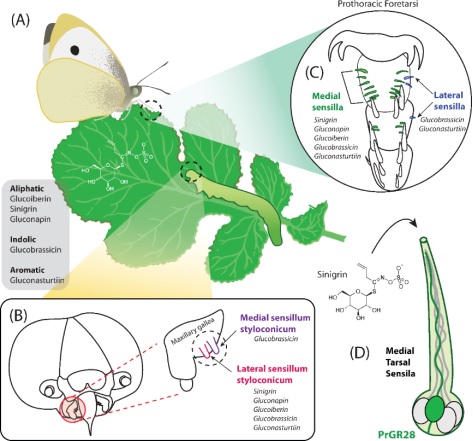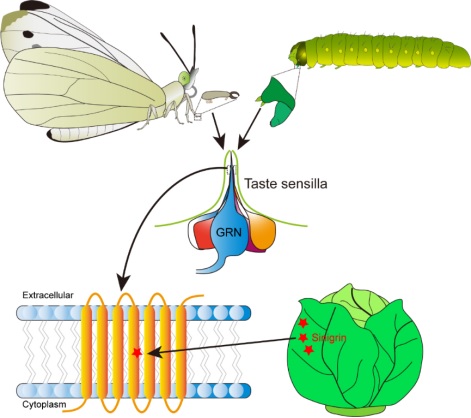Plants exist a large number of secondary metabolites with complex structures, which constitute the unique taste of each plant species. As an agricultural pest in the world, the caterpillars of cabbage butterfly Pieris rapae prefer to feed on cruciferous vegetables such as cabbage, cauliflower, rapeseed, radish and so on, because they are addicted to glucosinolates, a specific group of secondary metabolites in cruciferous plants. These compounds trigger neural firing in larval maxillary sensilla and adult tarsal sensilla, and induce feeding and oviposition responses.
Gustatory receptors (GRs) expressed in the gustatory receptor neurons (GRNs) in taste sensilla are involved in the recognition of different glucosinolates. For more than 100 years, scientists have done a lot of work to uncover the mystery of insect addiction to glucosinolates, but the GRs tuned to glucosinolates have been unknown.
In a study published on PLoS Genetics, a team led by Prof. WANG Chenzhu from the Institute of Zoology of the Chinese Academy of Sciences (CAS) uncovered that a bitter receptor in P. rapae is tuned to sinigrin, one of the most common and abundant glucosinolates in cruciferous plants.
Using a combination of behavioral, electrophysiological and molecular techniques and methods, the team investigated the molecular basis of glucosinolate detection of P. rapae at different levels. They found that five glucosinolates are the potent feeding stimulants for P. rapae larvae. Both larval maxilla and adult tarsi exist two types of taste sensilla responding to glucosinolates: one broadly responding to all tested glucosinolates, and another narrowly responding to the indolic and aromatic glucosinolates.
Based on transcriptome sequencing and quantitative Real-time PCR analyses, they identified two highly expressed bitter receptors, PrapGr28 and PrapGr15 in female tarsi, and speculated that the two receptors might be involved in the chemoreception of glucosinolates.
Subsequent functional analysis showed that the Xenopus oocytes only expressing PrapGr28 had specific responses to sinigrin by two-electrode voltage clamp. To further confirm the function of PrapGr28, they ectopically expressed PrapGr28 into Drosophila sweet GRNs. PrapGr28 expressed in these neurons conferred sensitivity of the L-type sensilla to sinigrin.
Finally, they used RNA interference experiments further showed that knockdown of PrapGr28 reduced the sensitivity of adult tarsal sensilla to sinigrin, confirming that the bitter receptor PrapGr28 is a gustatory receptor tuned to sinigrin in P. rapae.
"The current work on the functional identification is a major advance in the field of the neuroethology and sensory ecology of herbivorous insects, and it takes a significant step towards revealing the molecular basis of the taste addiction to glucosinolates in the crucifer specialist insects, as well as the secrets of the complex taste system in herbivorous insects," pointed out Prof. Noah K. Whiteman and Julianne N. Peláez from University of California, Berkeley, USA, who wrote a perspective article for this study in the same issue of PLoS Genetics.
The research was supported by the Strategic Priority Research Program of CAS and the National Natural Science Foundation of China.








